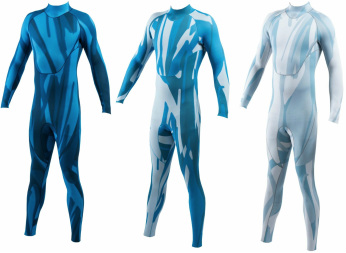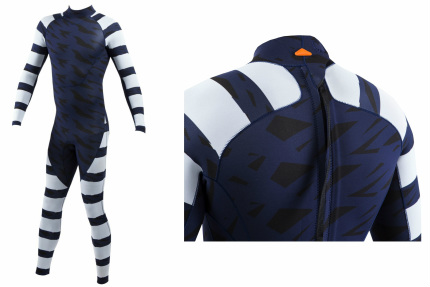I will readily admit to being intrigued by the various sorts of camouflage whether it is the newest variant being considered by the US military or the dazzle paint schemes used on naval ships during WWI and early WWII. Thanks to TheWorld.Org’s GeoQuiz I found another use: preventing shark attacks on surfers and divers.
A collaborative effort of Shark Attack Mitigation Systems and the Oceans Institute of the University of Western Australia seeks to reduce the number of shark attacks on swimmers, surfers, and divers. Western Australia ranks first in the world in the number of unprovoked great white shark attacks. Researchers found that while sharks use a number of senses to detect their prey, the sense of vision is the critical sense in the final stages of an attack.
The Oceans Institute team headed by Professor Shaun Collin and Professor Nathan Hart has been studying shark vision for a number of years and is considered the world leading authority in the field. The team has made a number of significant scientific discoveries relating to shark sensory systems – including the fact that sharks see in black and white.
Although sharks use a number of senses to locate prey, it is known that vision is the crucial sense in the final stage of an attack. By disrupting a shark’s visual perception, an attack can either be diverted altogether or at least delayed to allow time to exit the water.
Using this research, they developed two types of camouflage. The first, SAMS Cryptic(TM) technology, is used to make it difficult for the shark to actually see the swimmer or diver in the water. The goal is to make it difficult for the shark to actually see the swimmer. It uses disruptive patterns and coloration to allow the diver or swimmer to blend in with their background. This has been applied to the wetsuits shown below.
 |
| SAMS Cryptic(TM) |
The second type of camouflage is called SAMS Warning(TM) technology. This camouflage seeks to make the shark perceive the wearer as either a danger or unpalatable.
Scientists note the distinctive vivid coloration of many fish species, including the striped pilotfish which spends it’s life living alongside predatory sharks.
The SAMS Warning™ pattern is designed to overtly present the wearer as unlike any shark prey, or even as an unpalatable or dangerous food option. At the very least this will provide the user with increased protection, but it could also provide the time needed to evacuate the area if a shark is in range.
This zebra-like pattern has been applied to both surfer’s wetsuits and to hard objects such as surfboards, kayaks, and dive tanks.
 |
|
| SAMS Warning(TM) |
 |
|
| SAMS Warning(TM) decals |
As you would expect, it took a lot of testing to develop these patterns. The researchers tested various patterns extensively off the coast of Western Australia to come up these patterns. They do warn that they can’t guarantee that they will be 100% effective against shark attacks as they were developed in clear water and good light. Murky waters and other variables could reduce their effectiveness.
Camouflage – it’s not just for the tree stand and battlefield anymore.


